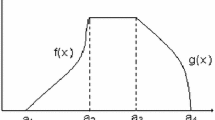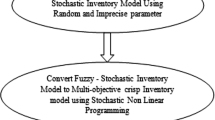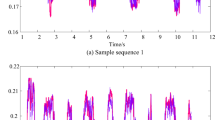Abstract
Multi-item inventory models with two storage facility and bulk release pattern are developed with linearly time dependent demand in a finite time horizon under crisp, stochastic and fuzzy-stochastic environments. Here different inventory parameters—holding costs, ordering costs, purchase costs, etc.—are assumed as probabilistic or fuzzy in nature. In particular cases stochastic and crisp models are derived. Models are formulated as profit maximization principle and three different approaches are proposed for solution. In the first approach, fuzzy extension principle is used to find membership function of the objective function and then it’s Graded Mean Integration Value (GMIV) for different optimistic levels are taken as equivalent stochastic objectives. Then the stochastic model is transformed to a constraint multi-objective programming problem using Stochastic Non-linear Programming (SNLP) technique. The multi-objective problems are transferred to single objective problems using Interactive Fuzzy Satisfising (IFS) technique. Finally, a Region Reducing Genetic Algorithm (RRGA) based on entropy has been developed and implemented to solve the single objective problems. In the second approach, the above GMIV (which is stochastic in nature) is optimized with some degree of probability and using SNLP technique model is transferred to an equivalent single objective crisp problem and solved using RRGA. In the third approach, objective function is optimized with some degree of possibility/necessity and following this approach model is transformed to an equivalent constrained stochastic programming problem. Then it is transformed to an equivalent single objective crisp problem using SNLP technique and solved via RRGA. The models are illustrated with some numerical examples and some sensitivity analyses have been presented.
Similar content being viewed by others
Explore related subjects
Discover the latest articles, news and stories from top researchers in related subjects.References
Bessaou M., Siarry P. (2001) A genetic algorithm with real-value coding to optimize multimodal continuous function. Structural and Multidisciplinary Optimization 23:63–74
Bhuina A.K., Maiti M. (1997). A two warehouse inventory model for a linear trend in demand. Opsearch 31:318–329
Chakraborty T., Chaudhuri K.S. (1997). An EOQ model for deteriorating items with a linear trend in demand and shortages. International Journal of Production Economics 49:205–213
Charnes A., Cooper W.W. (1959). Chance constrained programming. Management Science 6:73–79
Charnes A., Cooper W.W. (1977). Goal programming and multiple objective optimization. European Journal of Operations Research 1:39–54
Chen S.H., Hsieh C.H. (1999). Graded mean integration representation of generalized fuzzy numbers. Journal of Chinese Fuzzy Systems 5(2):1–7
Das K., Roy T.K., Maiti M. (2003). Multi-objective fuzzy inventory model for deteriorating items with shortages over a finite time horizon. Opsearch 40(4):252–277
Dubois D., Prade H. (1980). Fuzzy sets & systems: Theory and application. New York, Academic Press Inc.
Dubois D., Prade H. (1983). Ranking fuzzy numbers in the setting of possibility theory. Information Sciences 30:183–224
Goldberg D.E. (1989). Genetic algorithms: Search, optimization and machine learning. Massachusetts, Addison Wesley
Grzegorzewski P. (2002). Nearest interval approximation of a fuzzy number. Fuzzy Sets and systems 130:321–330
Hariga M.A., Benkherouf L. (1994). Optimal and heuristic inventory replenishment models for deteriorating items with exponential time-varying demand. European Journal of Operations Research 79:123–137
Heiiendoorn H., Thomas C. (1993). Defuzzification in fuzzy controller. Intelligent and Fuzzy Systems 1:109–123
Holland, H. J. (1975). Adaptation in natural and artificial systems. University of Michigan.
Kar S., Maiti M. (2001). Deterministic inventory model with two-levels of storage, a linear trend in demand and a fixed time horizon. Computers and Operational Research 28:1315–1331
Kirkpatrick S. (1984). Optimization by simulated annealing-quantitative studies. Journal of Statistical Physics 34:975–986
Lee C. (1990). Fuzzy logic in control systems: fuzzy logic controller, Parts I and Parts II. IEEE Transactions on Systems, Man and Cybernetics 20:404–435
Liu B., Iwamura K. (1996). A genetic algorithm for chance constraint programming. Journal of Information and Optimization Science 17:409–422
Liu B., Iwamura K. (1998). Chance constraint programming with fuzzy parameters. Fuzzy Sets and Systems 94:227–237
Liou T.S., Wang M.J.J. (1992). Ranking fuzzy numbers with integral values. Fuzzy Sets and Systems 50:247–255
Michalewicz Z. (1992). Genetic Algorithms + data structures= evolution programs. Berlin, Springer
Mohon, C. (2000). Optimization in fuzzy-stochastic environment and its importance in present day industrial scenario. In Proceedings on Mathematics and Its Application in Industry and Business. India: Narosa Publishing House.
Rao, S. S. (2000). Engineering optimization, theory and practice (pp. 715–761). India: New Age International (P) Limited.
Sakawa M. (1982). Interactive multi-objective decision making by the sequential proxy optimization technique SPOT. European Journal of Operations Research 9:386–396
Sakawa M., Yano H., Yumine T. (1987). An interactive fuzzy satisficing method for multi-objective linear-programming problems and it’s application. IEEE Transactions on Systems, Man and Cybernetics SMC 17(4):654–661
Sarma K.V.S. (1997). A deterministic order level inventory model for deteriorating items with two storage facilities. European Journal of Operations Research 29:70–72
Zadeh L.A. (1965). Fuzzy set. Information and Control 8:338–353
Zadeh, L. A. (1973). The concept of linguistic variable and its application to approximate reasoning. Memorandum ERL-M 411 Berkeley.
Zadeh L.A. (1978). Fuzzy sets as a basis for a theory of possibility. Fuzzy Sets and Systems 1:3–28
Zimmermann H.J. (1978). Fuzzy programming and linear programming with several objective function. Fuzzy Sets and System 1:45–53
Author information
Authors and Affiliations
Corresponding author
Rights and permissions
About this article
Cite this article
Maiti, M.K., Maiti, M. Two storage inventory model in a mixed environment. Fuzzy Optim Decis Making 6, 391–426 (2007). https://doi.org/10.1007/s10700-007-9020-z
Published:
Issue Date:
DOI: https://doi.org/10.1007/s10700-007-9020-z




